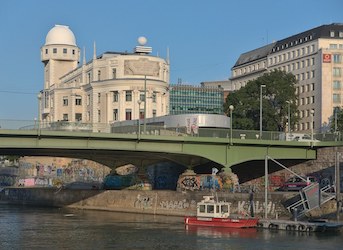
Leopoldstadt, Vienna, Austria. Vienna’s 2nd District is separated from the city center by the Danube Canal. The canal’s trendy beach bars are a popular summer hangout. Karmelitermarkt’s kosher food stalls are the hub of the traditionally Jewish neighborhood‘s hip culinary and arts scene. The iconic Riesenrad Ferris wheel overlooks Wurstelprater amusement park. The surrounding Prater is a vast green recreation space.
The high number of Jewish inhabitants led to the area being called Mazzesinsel (‘Island of Matzo’, referring to the unleavened bread eaten during Passover). Several important synagogues were located there, including the Schiff Shul, the Leopoldstädter Tempel, the Türkischer Tempel, the Polnische Schul, and the Pazmanitentempel, as well as yeshivas.
None of the synagogues escaped the destruction during the Kristallnacht pogroms of November 1938 following the annexation of Austria by Nazi Germany. A fragment of a Torah scroll was saved by Heschel Messias from one of the synagogues as it burned.
The Jewish population was increasingly isolated and terrorized and was finally deported and exterminated in concentration camps such as Auschwitz. The once thriving communal life was completely destroyed. Only a handful of survivors were able to hide until the end of the war, from an original population of several thousands.
With the fall of the Iron Curtain in 1989, and renewed immigration from Eastern Europe, especially the former Soviet Union, the Jewish population of Leopoldstadt was able to grow again.
Today, many members of Vienna’s Jewish community live there again, and there are a number of shops and restaurants selling kosher food. Several parts of the old residential areas have been gentrified, resulting in a gentle shift from Leopoldstadt’s traditional, predominantly working class roots towards a somewhat wealthier population.